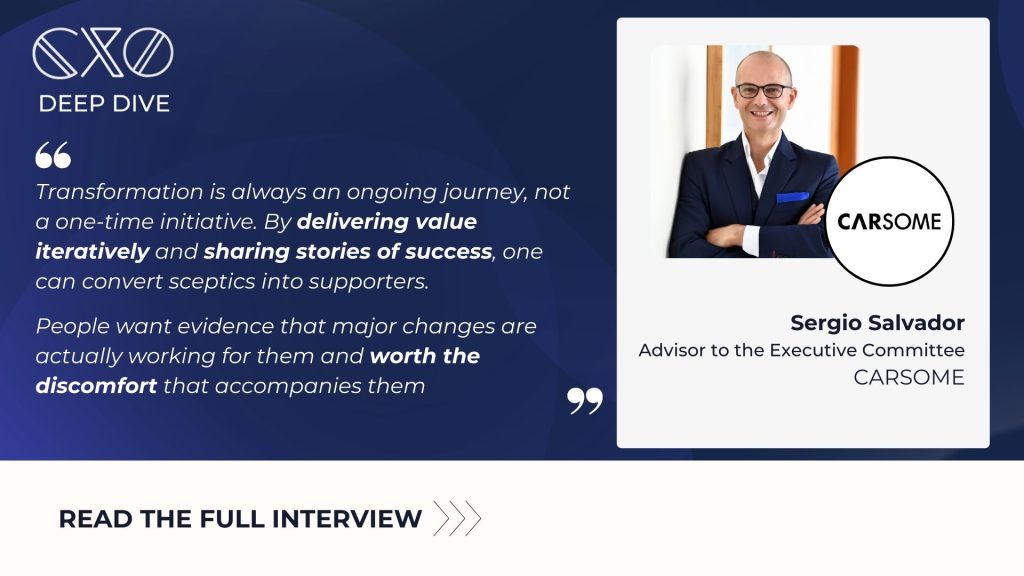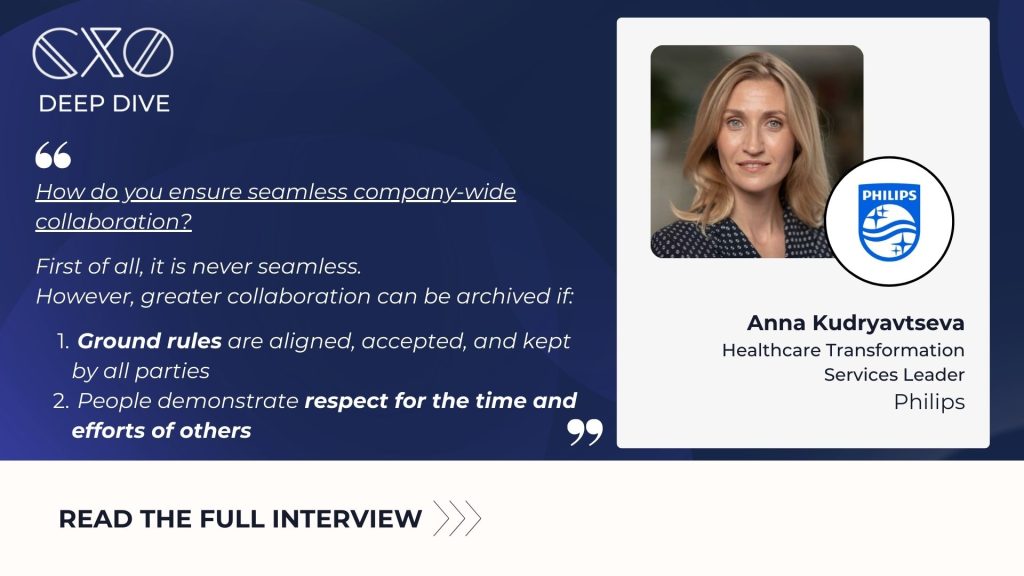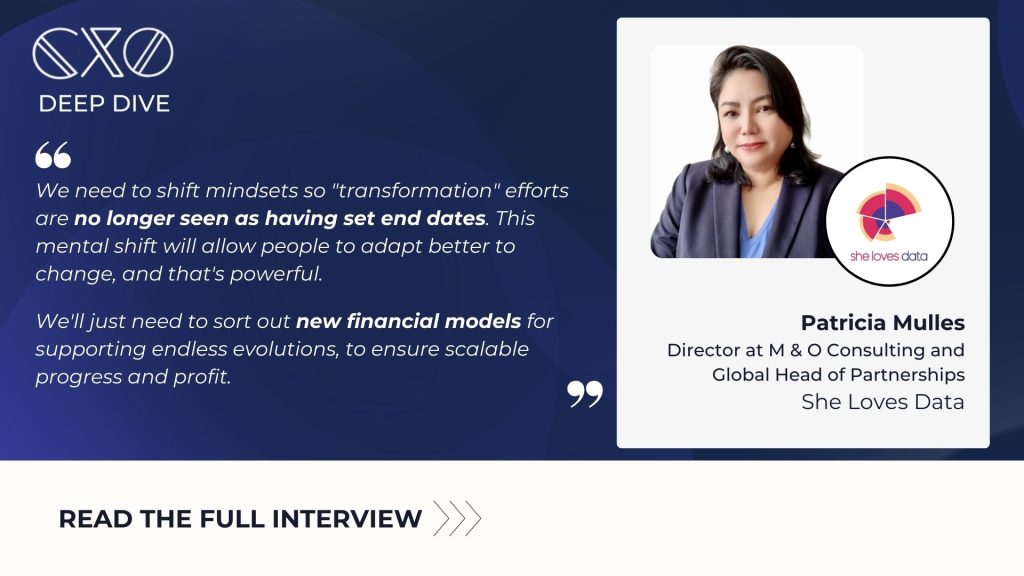Nawaz Imam, CFA – Group Head of Strategy, MoneyHero Group sharing his insights and experiences on Transformation Tools & Technologies, Organisational Transformation & Future Trends, as part of the CXO Deep Dive series.
How would you explain your job to a 5-year-old?
Aggregating consumer finance products through the internet. My job is to help organize and manage the future strategy of the company as it grows.
“There is no digital transformation, just transformation.” Do you agree or not? Why?
The transformation of the business does not merely rely on technology. It also involves rethinking business models, organizational culture, processes, and user experience. The implementation of new digital tools must align with a broader vision that considers these factors. If we view transformation as a holistic process, we assume that technology alone cannot drive meaningful change. Other dimensions, such as leadership, strategy, culture, and operational processes, play significant roles in determining success. However, we might overlook the specific challenges, methodologies, and strategies that are unique to digital transformation. It could also be seen as minimizing the importance of specialized skills and focus needed for the digital aspect.
In general, I would likely agree with this statement but with some qualifications. Emphasizing the interconnectedness of digital tools with overall organizational strategy and culture makes sense. However, recognizing the unique aspects of digital transformation is also essential, as it requires specific skills, tools, and strategies. Balancing these two perspectives could lead to a more effective and nuanced transformation strategy for the company.
What are the top challenges in your business transformation process?
Our main challenges are:
1. Aligning Transformation with Business Goals:
Ensuring that the transformation aligns with the overarching business strategy and objectives is paramount. The main challenge is getting the right understanding of conflicting goals and setting effective priorities, especially given that we operate across multiple products and markets. Misalignment could lead to conflicting priorities, wasted resources, and failure to meet organizational goals.
2. Measuring and Demonstrating ROI:
Transformation involves significant investments in time, money, and resources. In our case, we have complex transformation initiatives that touch multiple functions and drive different business drivers, leading indicators and hence, revenue and profitability.
3. Cultural Resistance and Change Management:
People are at the core of transformation, and their attitudes and behaviors must shift to support the new direction. Given the diversity of our workforce across multiple markets, ensuring this alignment is paramount.
“It’s crucial to deliver and communicate benefits fast, to build momentum and confidence in transformation projects where there might be scepticism.”
Do you agree? Or you have other thoughts on the timeline of a transformation project?
It’s vital. Transformation projects, particularly in a field that’s ever-changing like ours, need tangible success stories to build trust and momentum. These quick wins, even if they’re small, send a strong message that progress is happening. They’re not just morale boosters; they’re proof points that align with our strategic direction. When there’s skepticism, showing immediate benefits can turn doubters into believers and create a collective enthusiasm for the journey ahead. It’s about creating a shared vision and celebrating every step forward.
Do you see transformation as a distinct skillset, best delivered by “Transformation Experts”, or is it better to be led by the core business?
This is indeed a nuanced question, and the approach can vary depending on the specific situation and goals of the transformation. Here’s how I see these two perspectives:
Transformation as a Distinct Skillset:
Expertise: Transformation experts bring specialized knowledge, methodologies, and experience that can guide a complex change process.
Objective Perspective: External experts can offer an unbiased view and challenge existing paradigms within the organization.
Rapid Implementation: Their specific focus on transformation can drive a more efficient and focused process.
However: The risk here is potential misalignment with the core business culture or values, and a lack of deep understanding of specific operational intricacies.
Transformation Led by Core Business:
Alignment with Business Goals: Core business leaders have a profound understanding of the organization’s mission, values, and strategic goals, ensuring alignment with transformation efforts.
In-depth Industry Knowledge: They know the customers, products, market landscape, and internal dynamics, providing insights that external experts might miss.
Cultural Sensitivity: Leading transformation from within ensures that changes resonate with the existing organizational culture.
However: The challenge here can be a potential resistance to radical change, or the lack of specialized transformation methodologies and tools.
In my view, the most effective approach often involves a balanced combination of both. Utilizing transformation experts for their specialized skills and methodologies, while closely involving the core business team to ensure alignment with the organizational values and goals, can provide the best of both worlds.
The collaboration between external expertise and internal insights can foster a transformation that is not only innovative and efficient but also deeply rooted in the unique attributes and values of the business. This blended approach acknowledges the complexity of transformation and leverages diverse perspectives to drive meaningful and sustainable change.
How do you pick the right partners to accelerate digital transformation?
Absolutely, picking the right partners for digital transformation is key, and we focus on these five main areas:
Understanding Our Needs and Goals: Before exploring partnerships, we clearly outline what we aim to achieve with the transformation. This clarity guides us in identifying partners with the expertise that aligns with our specific objectives.
Evaluating Expertise and Experience: We look for collaborators with a proven track record in our industry. Their experience and understanding of our market are essential in delivering value and accelerating our transformation journey.
Alignment with Our Culture and Values: Beyond technical compatibility, the right partner must resonate with our organizational culture and values. This ensures that we share a common vision and can work smoothly together.
Engaging in Transparent Communication: Open and honest communication sets the stage for success. We establish clear expectations and maintain regular dialogue to foster a transparent and productive relationship.
Analyzing Cost-Effectiveness: While considering costs, we also evaluate the overall value the partner brings. We assess their offerings to ensure that they align with our budget and strategic priorities without compromising quality.
In sum, the process of selecting partners for digital transformation is a strategic exercise that encompasses a clear understanding of our goals, an assessment of expertise and cultural alignment, a commitment to transparency, and a thoughtful evaluation of cost-effectiveness. These factors collectively guide us in choosing collaborators who can truly accelerate our digital transformation efforts.
How do you ensure seamless company-wide collaboration?
Ensuring seamless company-wide collaboration is intrinsically linked to the implementation of effective cadences, which are regular and structured rhythms of meetings, communications, and check-ins. These cadences promote continuous alignment and foster communication across the organization. By establishing regular cadences that align with business goals, tailoring their frequency and content to the organization’s needs, and incorporating cross-functional collaboration, the entire organization can stay in sync. Leveraging technology further supports the scheduling and management of these rhythms, making the collaborative process more efficient and focused.
Continuous monitoring and adaptation of these cadences are also vital to maintaining their effectiveness. Regular evaluation, feedback, and adjustments ensure that the cadences remain relevant and adapt to the changing dynamics and needs of the organization. In summary, effective cadences act as the heartbeat of an organization, synchronizing efforts, breaking down silos, and fostering a unified approach to achieving collective goals. This structured approach enables a more agile and cohesive organization, adept at navigating the complexities of modern business.
What aspect(s) of business should organisations prioritise during digital transformation? Why?
Digital transformation, particularly in the fast-paced world of consumer finance aggregation, calls for a strategic focus on several key aspects. Here are the main areas organizations should prioritize, along with the reasoning behind each:
Customer Experience:
Why: Digital transformation often begins and ends with the customer. Enhancing customer experience ensures that the transformation aligns with what customers need and want.
Reasoning: Improved user interfaces, personalized services, and seamless multi-channel experiences increase customer satisfaction and loyalty, driving growth.
Data Integration and Analytics:
Why: The ability to collect, analyze, and leverage data is a cornerstone of modern business operations.
Reasoning: Integrating data across platforms provides actionable insights, supports decision-making, enables personalization, and fuels innovation.
Operational Efficiency:
Why: Streamlining operations through digital tools can lead to increased efficiency and reduced costs.
Reasoning: Automating manual processes, improving workflow management, and enhancing collaboration across teams boosts productivity and allows resources to be reallocated to more strategic initiatives.
Security and Compliance:
Why: With digital transformation comes increased risk around data security and the need for regulatory compliance.
Reasoning: Robust security measures protect sensitive information, build customer trust, and ensure compliance with industry regulations, mitigating legal and reputational risks.
Organizational Culture and Change Management:
Why: Digital transformation is not merely a technological shift; it’s a cultural one.
Reasoning: Ensuring that the organization’s culture supports innovation, agility, and continuous learning facilitates a smoother transformation. Effective change management helps in aligning teams and overcoming resistance.
Alignment with Business Strategy:
Why: Digital transformation must align with the broader business goals and strategy.
Reasoning: This alignment ensures that the transformation supports the organization’s overall mission, creating a coherent path towards achieving long-term objectives.
In conclusion, prioritizing these aspects during digital transformation helps in creating a customer-centric approach, leverages data for insights, enhances efficiency, ensures security, nurtures an adaptive culture, and aligns with the overall business strategy. These elements collectively contribute to a successful transformation that not only leverages digital tools but also strategically positions the organization for sustained growth and competitiveness.
How do you achieve successful change management and shifts in culture, mindset and behaviours to adopt new digital tools?
Achieving successful change management for adopting new digital tools necessitates a multifaceted approach. First, alignment with the organization’s vision ensures everyone understands the purpose and goals behind the change. Engaging leadership to champion the change, along with clear and transparent communication, builds trust and buy-in. Providing proper training and support equips employees with the skills to embrace new tools, while fostering a culture that values adaptation and innovation encourages a mindset open to change. Regular monitoring and celebration of progress maintain momentum, and an empathetic understanding of the human side of change helps in overcoming resistance. Together, these elements form a cohesive strategy that aligns technology with culture, mindset, and behaviors, leading to a successful and resonant transformation.
What do you ultimately do with people that do not want to change?
Handling individuals who resist change requires a nuanced approach. First, it’s essential to understand the root cause of the resistance through dialogue, as it may be addressed through additional support or training. Involving resistant individuals in the process can foster a sense of ownership and reduce opposition. Setting clear expectations and holding individuals accountable ensures that everyone understands the organizational direction. If resistance persists, an evaluation of the individual’s fit within the new direction of the company may be necessary, possibly leading to difficult decisions about their future role. This balanced approach aims to respect both the organization’s needs and the individual’s concerns, aligning efforts to achieve common goals.
What do you think is the biggest challenge organisations face in the adoption of AI?
Adopting AI in an organization presents a multifaceted challenge. Quality data is paramount for training robust AI models, yet obtaining this data can be a significant barrier. Coupled with the potential lack of in-house AI expertise, the complex ethical considerations, legal regulations, and the technical demands of integrating AI into existing systems, these factors constitute a considerable challenge. Overcoming employee resistance and demonstrating a clear return on investment further complicate the implementation process.
A strategic approach that narrows down the initial implementation into specific use cases can effectively address these challenges. By focusing on targeted applications that align with business goals, organizations can create a more manageable pathway for AI adoption. This focused strategy not only mitigates risks but also sets the stage for broader organizational adoption. It allows for a more tangible connection between AI efforts and the overarching objectives of the organization, thereby facilitating a smoother and more successful integration of AI into the business landscape.
Do you expect certain uses of technology to decline in the near future?
The shift away from legacy methods of creating content, such as traditional content management systems (CMS), is a noteworthy trend in the evolving technological landscape. Traditional CMS platforms, though once prevalent, are now seen as rigid and complex in comparison to modern alternatives like headless CMS architectures. These newer solutions offer greater customization, collaboration, and integration capabilities, making them more aligned with the demands of omnichannel content delivery. As a result, legacy content creation methods are experiencing a decline as organizations seek more agile and adaptable tools.
Similarly, the way we approach complex queries is changing, particularly those related to specific user needs. While general search engines have served as the primary source for information retrieval, their effectiveness with nuanced or industry-specific inquiries is being challenged by the rise of specialized databases and AI-driven search tools. These platforms can process complex queries with a higher degree of accuracy and contextual relevance. This shift towards specialized systems for intricate searches reflects a broader trend towards efficiency and user-centered design, leading to a potential decrease in reliance on traditional search engines for such tasks.
How do you keep pace with rapid obsolescence in technology? How do you figure out stuff that will be relevant from a future perspective and have longevity from an investment perspective?
Keeping pace with rapid technological obsolescence requires a multi-pronged strategy. Continuous monitoring and learning, through means like regular training, conferences, and industry collaboration, fosters an environment attuned to emerging trends. Implementing agile development practices and maintaining strong vendor partnerships can further enhance adaptability. Additionally, technology lifecycle management, which includes regular reviews and understanding the lifecycle of technologies, can provide early warnings, allowing organizations to phase out or adopt technologies as needed.
Investing in technologies with future relevance and longevity is another intricate challenge. This involves aligning technology investments with long-term business strategies, emphasizing areas with predicted future importance. Investment in Research & Development (R&D), either internally or through partnerships, can uncover opportunities in emerging areas, while conducting risk assessments and diversifying investments can mitigate potential pitfalls. Lastly, prioritizing interoperability and modularity in systems design helps in future-proofing, ensuring that parts of the system can be updated or replaced without needing a complete overhaul. This comprehensive approach ensures that investments are both responsive to current trends and strategically positioned for future growth and sustainability.
How is your industry preparing for an AI-Centric world?
The shift towards an AI-centric world has profound implications for the industry, especially in the realm of consumer finance aggregation. The preparation for this shift encompasses several key areas, with particular emphasis on enhancing internal processes and user engagement. Here’s an elaboration in two paragraphs:
Using AI to Improve Internal Processes, Particularly Around Content Creation and Knowledge Management:
The industry is leveraging AI to automate and enhance various internal processes. In content creation, AI algorithms are being employed to generate personalized reports, analyze trends, and provide insights, significantly reducing the time and human effort required. Knowledge management is also being revolutionized through AI-driven data mining and processing, allowing for the swift retrieval and organization of vast information reservoirs. This leads to better decision-making, streamlined workflows, and increased efficiency. AI’s ability to learn and adapt is being harnessed to create systems that continuously evolve, becoming more proficient in handling complex tasks and improving overall productivity.
AI-Driven User Engagement Systems, Such as Chatbots:
On the user engagement front, AI-driven chatbots are becoming a central feature. These advanced chatbots are capable of handling a wide range of customer inquiries, from simple FAQs to complex financial queries, providing personalized, real-time assistance. The integration of Natural Language Processing (NLP) and Machine Learning (ML) enables these chatbots to understand and respond to user needs more accurately and intuitively. By providing 24/7 support and reducing the need for human intervention, they not only enhance customer experience but also allow human resources to focus on more complex and value-added tasks. This transformation in customer engagement is not just improving efficiency but also driving a more responsive and tailored user experience.
In summary, the industry’s preparation for an AI-centric world is focused on harnessing the transformative potential of AI to reengineer internal operations and redefine user engagement. By integrating AI into content creation, knowledge management, and customer support systems, the industry is positioning itself at the forefront of innovation, aligning with future trends, and laying the groundwork for a more agile, efficient, and customer-centric ecosystem.
What technology / solution would you invest in if you were an Angel Investor?
My investment preferences would likely align with innovations that have the potential to redefine or enhance industry practices. Here are two key areas that could be of particular interest:
AI-Enhanced Financial Tools and Platforms:
As the industry gravitates towards personalization and automation, AI-driven financial tools offer enormous potential. These could include platforms that use Machine Learning algorithms to provide personalized investment advice, risk assessment, or fraud detection. Investing in start-ups or emerging companies that are innovatively applying AI to financial services can align with both current industry needs and long-term growth prospects.
Sustainable Technology Solutions:
Sustainability is a global concern, and there’s a growing demand for technologies that can enable greener practices across industries, including finance. Solutions that promote ethical investing, energy-efficient data centers, or technologies that aid in the assessment and reduction of environmental risks in financial portfolios could be attractive investment areas. These align with global sustainability goals and can provide a competitive edge in an increasingly eco-conscious market.
It’s worth noting that the investment would be determined not only by the technology’s potential but also by the team’s capabilities, the viability of the business model, the competitive landscape, and the alignment with broader market and societal trends. Diligence in research, a clear understanding of the industry dynamics, and collaboration with experts would be essential components of the decision-making process to ensure that the investment aligns with both current opportunities and future potential.
At the end of our interview, what do you want to say to our CXO community?
The future looks bright but it is ultimately up to us to implement the change that we want to see in the world!
A big thank you to Nawaz for sharing the insights on Transformation Tools & Technologies, Organisational Transformation & Future Trends!
Visit our content library for more insights from the CXOs: https://cxoinnovation.com/content-library/
Join our LinkedIn CXO Community.





